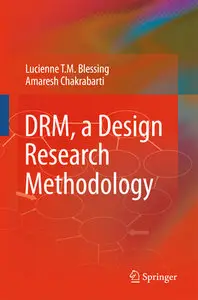"DRM, a Design Research Methodology" by Lucienne T.M. Blessing, Amaresh Chakrabarti
Sрringеr | 2009 | ISBN: 1848825862 9781848825864 9781848825871 | 411 pages | PDF | 6 MB
Sрringеr | 2009 | ISBN: 1848825862 9781848825864 9781848825871 | 411 pages | PDF | 6 MB
This study gives rise, for the first time, to a generic and systematic design research methodology intended to improve the quality of design research – its academic credibility, industrial significance and societal contribution – by enabling more thorough, efficient and effective procedures. Shows readers how to reflect on their own processes and methods for designing, using this understanding to devise new and more effective ways to design. Demonstrates methods of doing design research which will increase its industrial significance and academic standing by increasing procedural rigor and systematizing improvements in methods
This book speaks to a broad readership: it will provide the graduate student with an excellent grounding in good design research practice, inculcating good habits of research for the future and showing how the process of understanding and improving design can become more effective and efficient; it will interest the academic and industrial researcher as a source of useful and well-ordered methods within a common design research ethos, as well as a methodological framework for research projects and programmes; it will attract the supervisors of young researchers by offering research methods and a well-thought-out and logically structured research process for use in courses on design research.
Contents
1. Introduction
1.1 Design
1.2 Design Research
1.3 Main Issues
1.4 Need for a Design Reseach Methodology
1.5 Objectives
1.6 Structure of This Book
1.7 Mam Points
2. DRM: A Design Reseacli Methodology
2.1 Introduction
2.2 Methodological Framework
2.3 Types of Research Within the DRM Framework
2.4 Representing Existing and Desired Situations
2.5 Success Criteria and Measureable Success Criteria
2.6 The Main Stages
2.7 Comparison with Other Methodologies
2.8 Main Points
3. Reseach Clarification
3.1 Research Clarification Process
3.2 Identifying Ov erall Topic of Interest
3.3 Clarifying Current Understanding and Expectations
3.4 Clarifying Criteria, Main Questions and Hypotheses
3.5 Selecting Type of Research
3.6 Determining Areas of Relevance and Contribution
3.7 Formulating Overall Research Plan
3.8 General Guidelines on Doing Research
3.9 Main Points
4. Descriptive Study I: Understanding Design
4.1 Schools of Thought
4.2 Types of DS-I
4.3 DS-I Process Steps
4.4 Reviewing Literature
4.5 Determining Research Focus
4.6 Developing Research Plan for DS-I
4.7 Undertaking an Empirical Study
4.8 Drawing Overall Conclusions
4.9 Main Points
5 Prescriptive Study: Developing Design Support
5.1 Types of Design Support
5.2 Types of PS
5.3 A Systematic PS Process
5.4 Task Clarification
5.5 Conceptualisation
5.6 Elaboration
5.7 Realisation
5.8 Support Evaluation
5.9 Mam Points
6 Descritptive Study II: Evaluating Design Support
6.1 Evaluation
6.2 Types of DS-II
6.3 Systematic DS-П Process
6.4 Reviewing Existing Documentation
6.5 Determining Evaluation Focus
6.6 Developing Evaluation Plan(s)
6.1 Undertaking Evaluation
6.8 Drawing Ov erall Conclusions
6.9 Main Points
7 Writing Up: Publishing Results
7.1 Various Forms of Publication and Their Intent
7.2 Overall Structure of a Thesis
7.3 Approaches to Help Structure a Thesis
7.4 Tips on Writing Specific Sections
7.5 Writing Papers
7.6 General Guidelines
7.7 Main Points
8 Summary and Conclusions
8.1 Experience of Using DRM
8.2 Further Research
A Descriptive Study Methods
A.1 Paradigms and Assumptions
A.2 Reviewing Empirical Studies
A.3 Laboratory’ Versus Industrial Environment
A.4 Data-collection Methods
A.5 Statistical Analysis
В Prescriptive Study Methods
B.1 Product Development Methodologies
B.2 Software Development Approaches
B.3 User-interface Design
B.4 Support Outline: Summarising Scope and Assumptions
С Example Research Projects
C.1 Overview of the Examples
C.2 A Process-based Approach to Computer-supported Engineering Design
C.3 A Program for Computational Synthesis and Conceptual Design Support
C.4 Teamwork in Engineering Design
C.5 Measuring Conceptual Design Process Performance in Mechanical Engineering: A Question-based Approach
C.6 Design for Quality
C.7 Multi-disciplinary Design Problems
C.8 Design for Reliability in Mechanical System
References
Index
with TOC BookMarkLinks



